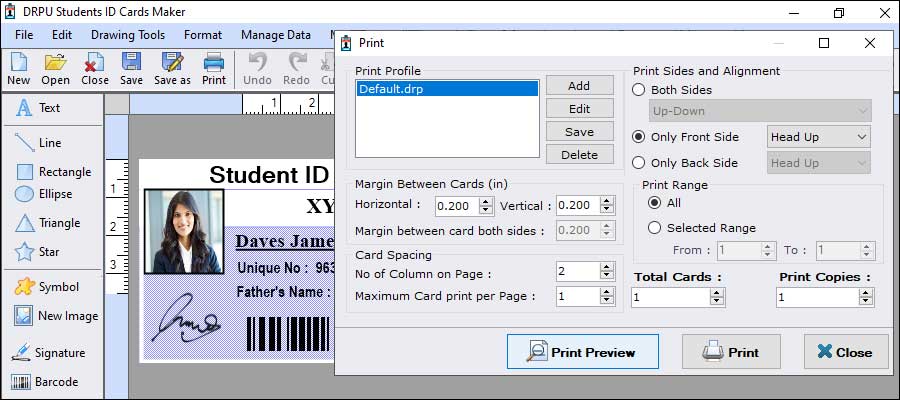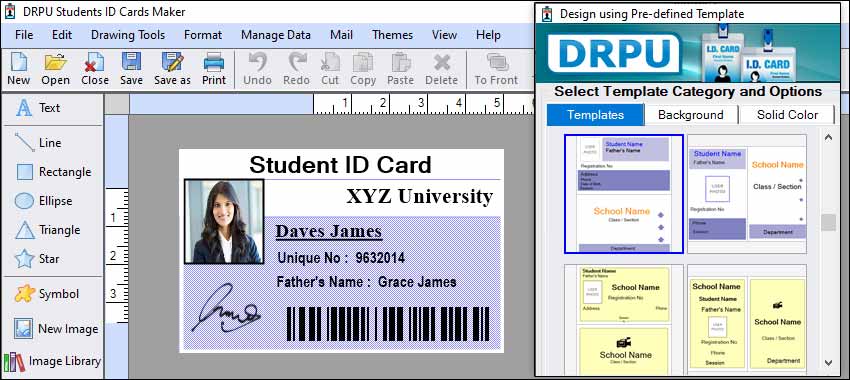The Printing Options Available in Student ID Card Software
Student ID card software typically provides a range of printing options to ensure flexibility and compatibility with various printing devices. These options allow you to customize the printing settings according to your specific requirements. Here are some common printing options available in student ID card software, along with their explanations:

-
Printer Selection:
ID card software enables you to choose the printer you want to use for printing the ID cards. The software usually detects the printers connected to your computer, and you can select the desired printer from a list. This option is particularly useful if you have multiple printers available or if you want to select a specific printer with certain capabilities, such as high-resolution printing or dual-sided printing.
-
Card Size and Type:
ID card software offers options to select the card size and type that matches your specific requirements. Common card sizes include standard credit card size (CR80) or custom sizes. The software may provide predefined templates for different card sizes, or you can input custom dimensions. Additionally, you can select the card type, such as PVC or adhesive labels, based on the printing media you plan to use.
-
Layout and Orientation:
You can typically adjust the layout and orientation of the ID card design before printing. The software allows you to select between portrait and landscape orientations, ensuring that the ID card is printed in the desired direction. Additionally, you can set the page margins and adjust the card positioning on the printing media to ensure accurate alignment.
-
Image Quality and Resolution:
To achieve optimal print quality, student ID card software allows you to adjust the image quality and resolution settings. You can specify the desired image resolution, usually in dots per inch (DPI), to ensure clear and sharp images on the printed ID cards. Higher resolutions result in better image quality but may increase file size and printing time.
-
Color Management:
If your ID card design includes colors, the software often provides color management options. This includes selecting color modes like RGB or CMYK, adjusting color saturation, brightness, and contrast, and choosing the color profiles for accurate color reproduction. These options help ensure that the printed ID cards match the intended color scheme of your design.
-
Duplex Printing:
If your ID cards require printing on both sides, the software usually offers duplex printing options. You can specify whether you want to print on one side only or print the front and back sides of the card consecutively. Duplex printing eliminates the need to manually flip the cards and ensures a seamless printing experience.
-
Batch Printing and Quantity Control:
Student ID card software often supports batch printing, allowing you to print multiple ID cards simultaneously. You can specify the quantity of ID cards you want to print and the software automatically generates individual cards for each student. This feature is especially useful for printing a large number of ID cards efficiently.
-
Print Preview:
Before sending the ID card design to the printer, the software typically provides a print preview feature. This allows you to review how the final printed ID cards will appear. You can verify the layout, alignment, colors, and other design elements to ensure everything looks as expected before initiating the printing process.
It's worth noting that the availability of these printing options may vary depending on the specific student ID card software you are using.
The Design Tools are Available in Student ID Card Software
Student ID Card Software typically provides various design tools to create and customize student identification cards. While specific software offerings may differ, here are some common design tools you can expect to find:
-
Templates:
Student ID Card Software often includes a range of pre-designed templates that serve as a starting point for creating ID cards. These templates are professionally crafted and can be customized with your school's branding, colors, logo, and other relevant information.
-
Text Editing:
The software will offer text editing tools that allow you to add and manipulate text on the ID card. You can choose different fonts, sizes, colors, and styles for the text. It should support various text alignment options, such as left, right, center, and justify.
-
Image and Logo Upload:
You can typically upload your school's logo, mascot, or any other relevant images to personalize the ID cards. The software should offer options to resize, crop, and position images on the card.
-
Barcode and QR Code Generator:
Many ID Card Software tools provide built-in barcode and QR code generators. You can input relevant data or student information, and the software will generate a scannable barcode or QR code that can be printed on the ID cards. This feature is useful for tracking attendance, library access, or any other student-related activities.
-
Shapes and Graphics:
Design tools usually include a library of shapes, symbols, icons, and graphic elements that can be added to the ID cards. These help in enhancing the design and can represent different departments, clubs, or organizations within the school.
-
Backgrounds and Colors:
You can choose and customize the background color or select from a collection of pre-set backgrounds. The software may allow you to add gradients, textures, or patterns to create visually appealing ID cards.
-
Layers and Alignment:
Advanced ID Card Software may offer layer functionality similar to graphic design tools. This allows you to organize elements of the ID card into different layers, making it easier to manage and edit individual components. Alignment tools assist in positioning elements precisely on the card.
-
Preview and Print:
Once you have designed the ID cards, the software should allow you to preview the final output before printing. It should provide options for adjusting print settings, such as card size, margins, and printer settings. Some software may even support batch printing for multiple ID cards.
-
Photo Editing:
Some software provides basic photo editing tools, allowing you to crop, resize, rotate, and apply filters to student photos. This ensures consistency in the appearance of student images on ID cards.
-
Barcodes and Magnetic Strips:
If your ID cards include barcodes or magnetic strips for specific purposes like access control or student verification, the software should provide tools to incorporate these elements and configure their properties.
In conclusion, Remember that the availability and features of design tools may vary depending on the specific Student ID Card Software you are using. It's always advisable to explore the documentation or trial version of the software to get a comprehensive understanding of the available design tools and features.
Can I Create Custom Templates using Student ID Card Software
Yes, you can create custom templates using student ID card software. Custom templates allow you to design ID cards that align with your institution's branding and specific requirements. Here's a detailed explanation of how you can create custom templates using student ID card software:

-
Template creation feature:
The student ID card software should provide a template creation feature that allows you to design and customize the layout of your ID cards. This feature is typically accessible through a design editor or a dedicated template creation tool.
-
Design customization options: The software should offer a range
of customization options
to create unique and visually appealing ID card templates.
Look for features such as:
-
Layout options: The ability to choose different card sizes (credit card size or ID-1 size) and adjust the placement of various elements on the card, including text, images, and barcode/QR code areas.
-
Text customization: Options to select font styles, sizes, colors, and alignment for different text elements on the card. This includes student names, ID numbers, institution name, and any additional information required.
-
Image insertion: The software should allow you to insert images, such as your institution's logo, student photos, or other relevant graphics. Ensure that the software provides tools for resizing, cropping, and positioning images within the template.
-
Color and background customization: The ability to choose background colors or patterns that align with your institution's branding. Additionally, the software should offer options to customize the color of text and other design elements for better visibility and aesthetics.
-
Design elements: Look for tools that enable you to add design elements like shapes, lines, borders, or watermark effects to enhance the visual appeal of the ID card template.
-
-
Variable data fields:
The software should allow you to insert variable data fields within the template. These fields act as placeholders for student-specific information, such as names, ID numbers, or encoded data. This feature enables you to create a single template design that can be populated with individual student details during the card printing process.
-
Preview and testing:
As you customize the template, the software should provide a preview feature that allows you to see how the final ID card will look. This helps you ensure that the design elements are properly aligned, the text is legible, and the overall layout meets your requirements.
-
Saving and reusing templates:
Once you've created a custom ID card template, the software should allow you to save it for future use. This enables you to easily replicate the design for new batches of student ID cards or make any necessary modifications in the future.
-
Template sharing and collaboration:
In some cases, you may need to collaborate with others to create or modify ID card templates. The software should offer features for sharing templates with colleagues or team members, allowing them to contribute to the design process.
-
Template library:
Some student ID card software may also provide a template library where you can access pre-designed templates created by the software provider or other users. These templates can serve as a starting point for customization or provide inspiration for your own designs.
In conclusion, By utilizing the custom template creation features provided by student ID card software, you can design ID cards that are unique to your institution, incorporate branding elements, and meet your specific requirements. These templates can be saved and reused, simplifying the card creation process for future use.